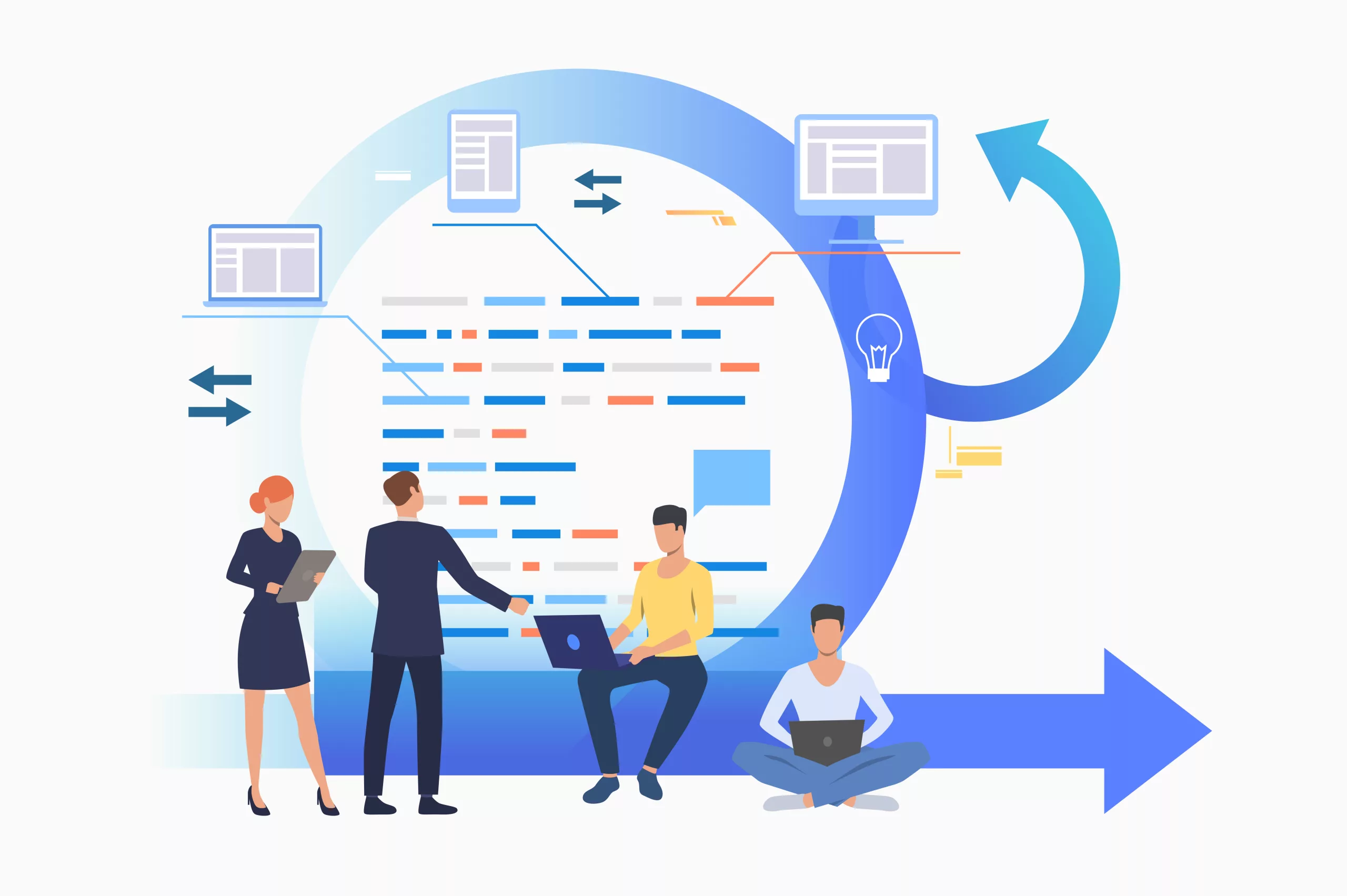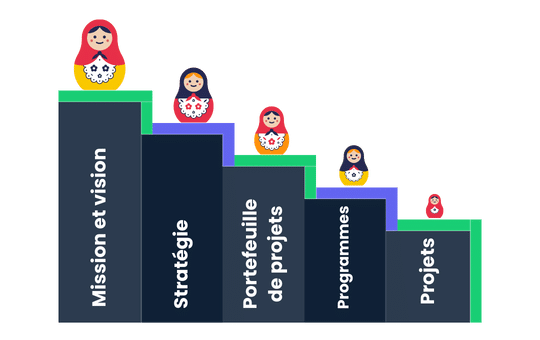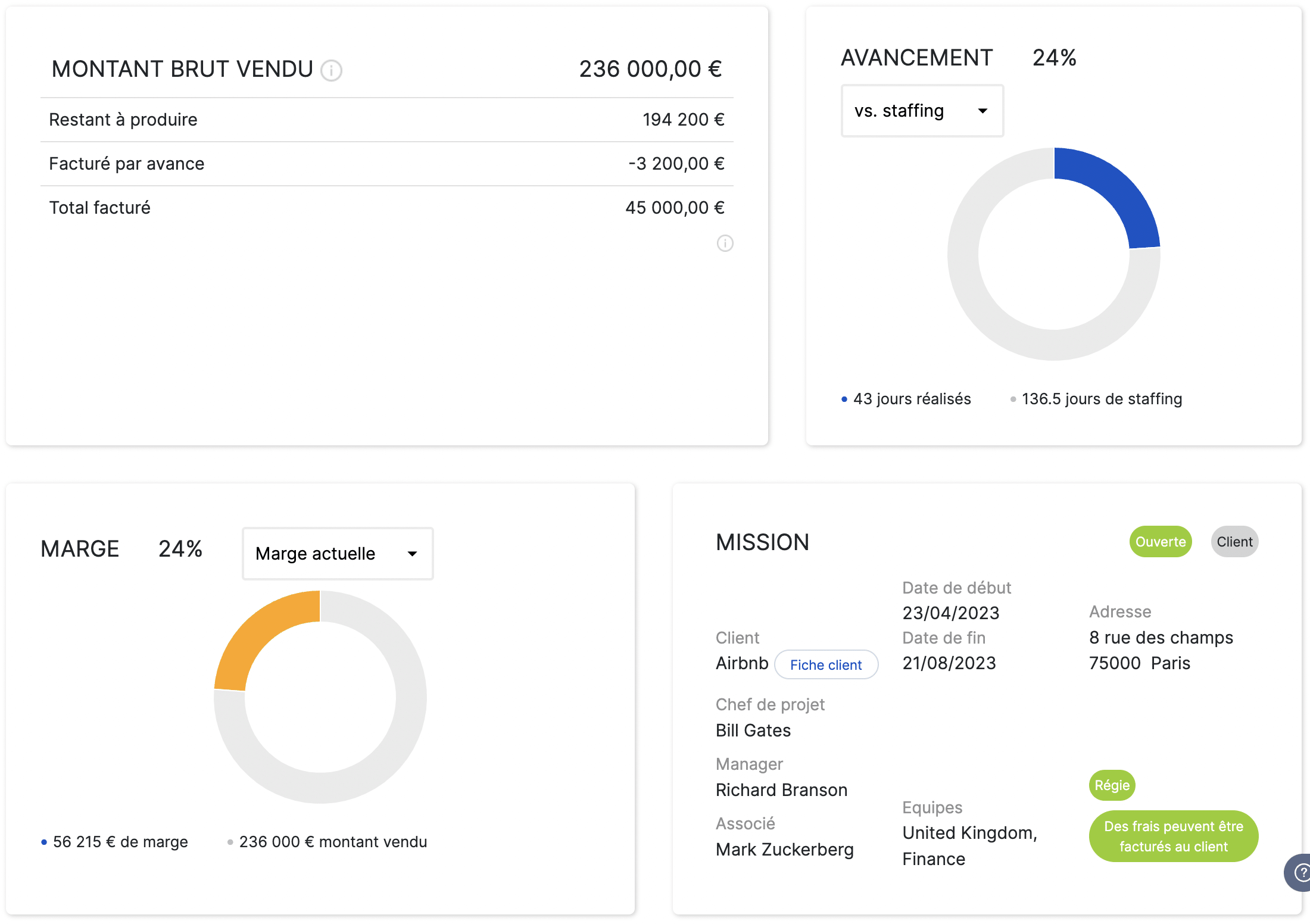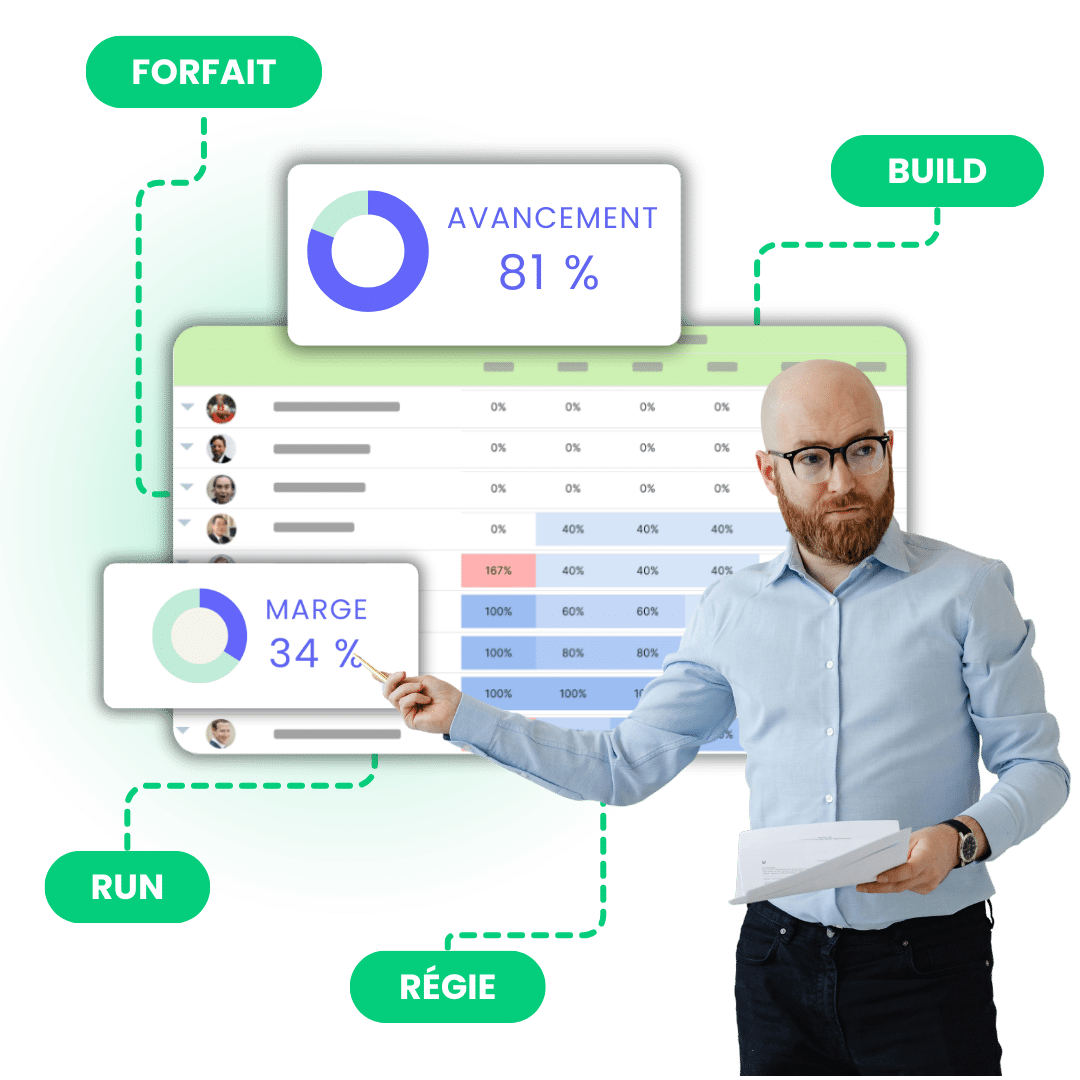Gestion de programme et GPP/PPM : enjeux & bonnes pratiques

Moins connue que la gestion de projet ou de portefeuilles, la gestion de programme a pourtant un rôle capital au sein d’une entreprise. Elle accompagne la réalisation d’objectifs stratégiques pour l’organisation.
Avant d’en arriver là, il faut toutefois bien comprendre de quoi il s’agit. Dans cet article, nous vous proposons un guide pour clarifier ce qu’est la gestion de programme et en quoi elle se révèle stratégique pour votre entreprise.
1. Comprendre la différence entre gestion de programme et gestion de projet
Souvent confondue avec la gestion de projet, nous avions à cœur de redéfinir la gestion de programme pour éviter tout risque de confusion.
A) Définition du “programme”
Voici la définition proposée par le Project Management Institute(PMI) :
B) Concrètement : qu’est-ce qu’une gestion de programme ?
La gestion de programme consiste finalement à coordonner un ensemble de projets interconnectés. Leur gestion commune apporte des avantages impossibles à obtenir autrement, comme des optimisations financières et au niveau des ressources humaines.
C) Gestion de projet vs Gestion de programme
Un projet consiste en une succession de tâches afin de voir un objectif défini se réaliser. La gestion de projet consiste donc à traiter ce périmètre.
Contrairement au projet, le programme désigne un ensemble de projets liés les uns aux autres. Grâce à une optimisation des ressources et une coordination précise, ils doivent permettre d’atteindre des objectifs stratégiques pour l’entreprise.
Chaque projet est généralement géré par un chef de projet. Lorsque vous êtes face à plusieurs chefs de projet qui doivent être coordonnés, il s’agit d’un programme.
D) Un exemple de programme : la traduction des paroles chez Deezer
Prenons un exemple concret. L’entreprise de streaming musical Deezer a récemment développé une fonctionnalité de traduction de paroles. Cela a impliqué un découpage des tâches :
- Recherches pour vérifier les intuitions sur la pertinence de cette fonctionnalité
- Validation de la viabilité du projet d’un point de vue légal
- Construction de partenariats avec les prestataires fournissant les paroles et la traduction
- Refonte de l’expérience utilisateur
- Coordination du lancement avec les équipes produit et marketing
- Identification d’optimisation
- Analyse des retours utilisateurs
Finalement, le développement de cette fonctionnalité permettant d’afficher la traduction des paroles peut être perçu comme un programme, composé de différents projets. Ces derniers s’articulent afin d’atteindre l’alignement stratégique pour Deezer :
- L’amélioration de l’expérience utilisateur
- L’augmentation du temps passé sur l’application
- Une preuve d’innovation et un avantage concurrentiel
2. Comprendre la différence entre gestion de programme et gestion de portefeuilles de projets
Imaginons la gestion d’une entreprise comme une collection de poupées russes.
Le projet fait partie du programme, lui-même faisant partie du portefeuille de projets. Voici une structure qui devrait vous éclairer :
- Mission et vision
- Stratégie
- Portefeuille de projets
- Programmes
- Projets

Le portefeuille de projets peut contenir plusieurs programmes ou plusieurs projets, qui ne sont pas forcément interdépendants les uns des autres.
Toutefois, comme pour la gestion de programme, la gestion d’un portefeuille de projets implique d’avancer vers une direction stratégique pour l’entreprise. Cela n’est pas nécessairement le cas d’un projet. Pour en savoir plus, consultez notre article sur les bases de la gestion de portefeuilles de projets.
3. Pourquoi mettre en place une gestion de programme ?
A) Obtenir une vision d’ensemble
Mettre en place une gestion de programme est une action structurante pour l’entreprise. En effet, la gestion de programme offre une vue d’ensemble sur les projets et surtout, leurs interdépendances.
La coordination des ressources financières et humaines permet d’aligner les objectifs de chaque projet à la stratégie globale de l’entreprise. La gestion de programme met en place la structure nécessaire pour coordonner, prioriser et gérer les interdépendances de projets, bien souvent inter-fonctionnels entre les départements.
B) Optimiser ses ressources
La mise en place d’une gouvernance de projet aide grandement à simplifier l’allocation des ressources. C’est également le cas pour la gestion de programme.
-
Financières :
La vision globale offerte par la gestion de programme vous aide à anticiper, allouer et adapter vos budgets en toute transparence.
-
Humaines :
Évaluer les interdépendances entre les projets permet d’optimiser la répartition de vos collaborateurs. Vos talents pourraient ainsi évoluer en même temps sur plusieurs projets de votre programme.
Cela présente plusieurs avantages :
-
- L’amélioration de la satisfaction : cela offre une vision transparente sur l’organisation et sur les opportunités de transversalité, renforçant ainsi la confiance
- Un gain de temps : la connaissance des environnements limite les temps de formation. Cela facilite les actions groupées et permet d’avancer en simultané sur les différents projets.
- Un gain financier : les dépenses en formation et recrutement peuvent être optimisées et revues à la baisse
La plateforme Stafiz digitalise votre gestion des ressources et permet d’atteindre vos différents objectifs :
- optimiser les taux d’occupation,
- garder les collaborateurs engagés,
- d’avoir une visibilité sur les projets réellement en cours, mais aussi prévisionnelle pour anticiper vos recrutements.
- respecter les budgets projets grâce à une vision temps réel et prévisionnelle dîtes “à l’atterrissage” des impacts financiers de toutes vos actions
=> Si vous préférez être guidé, découvrez notre guide de la gestion des ressources efficace.

Livre blanc
Le guide pour implémenter une démarche de staffing efficace
5 clés pour atteindre vos objectifs de staffing.
C) Améliorer le contrôle sur les risques et opportunités
La gestion de programme, en offrant une vue d’ensemble, améliore la gestion des risques et opportunités en permettant :
- D’améliorer l’anticipation
- De reporter les échéances lorsque cela est nécessaire
- D’identifier d’éventuelles opportunités
- De gérer les conflits pouvant impacter l’ensemble de l’organisation
Outil de gestion de programme, Stafiz propose des fonctionnalités afin de vous aider à gérer au mieux les risques et opportunités :
- Des alertes pour identifier les risques en prévisionnel
- Des tableaux de bord complets pour vous faire gagner en flexibilité et en agilité : vous pouvez aisément décaler vos ressources en cas de risques ou re-prioriser vos projets
- Une synchronisation avec l’environnement de travail
- Un suivi des bons de commandes et des factures pour un meilleur suivi
4. Comment mettre en place une gestion de programme optimale ?
A) Vérifier la compatibilité de votre structure avec la gestion de programme
Si vous avez l’intention de mettre en place une gestion de programme dans votre entreprise, assurez-vous que votre structure actuelle puisse supporter une telle méthodologie. En effet, elle nécessite de nombreuses ressources et s’adresse de ce fait à des organisations avec un niveau de maturité élevé.
Guider les équipes, structurer l’organisation et coordonner l’ensemble requièrent un niveau de leadership et de management élevés.
D’importantes ressources sont nécessaires, d’un point de vue financier et humain pour établir une transversalité optimale. Enfin, des processus de communications bien établis sont indispensables.
B) Définir une stratégie claire
Mettre en place une gestion de programme efficace implique de solides compétences de coordination et la définition d’un plan d’action précis.
-
Identifier les objectifs
La première étape consiste donc à définir les objectifs et à identifier les indicateurs clés (KPIs) qui serviront à évaluer leur performance.
-
Construire une feuille de route
La deuxième étape vous demandera l’élaboration d’une feuille de route composée de :
-
- La liste des projets appartenant au programme
- Un calendrier
- Les étapes clés
- Des objectifs stratégiques auxquels le programme répond
La feuille de route s’avère un excellent moyen visuel pour non seulement organiser, mais également communiquer efficacement votre plan d’action au sein de l’organisation. Le faire-savoir est tout aussi important que le savoir-faire.
-
Planifier et exécuter
La suite de l’implémentation d’une gestion de programme comprendra :
-
- La planification
- L’exécution
- La coordination
- Le contrôle
La coordination de projets multiples et le contrôle interviendront tout au long du déroulé du programme. Pour cela, utilisez des métriques précises qui vous aideront à évaluer la performance, l’efficacité et la rentabilité d’un programme.
Vous trouverez plusieurs types de métriques, en voici quelques unes :
- Les métriques financières : le coût total du programme, le retour sur investissement
- Les métriques opérationnelles : le taux de réalisation des tâches, le temps moyen d’un cycle

C) Désigner un responsable de programme
Tel le chef de projet pour la gestion de projet, le gestionnaire de programme a pour rôle de coordonner le programme. Il est important de désigner rapidement ce responsable en charge du bon déroulé du programme dont les tâches sont nombreuses :
- Concevoir les feuilles de route
- Vérifier que les projets sont cohérent avec la vision stratégique de l’entreprise
- Suivre les états d’avancement
- Coordonner les chefs de projet
- Organiser les ressources
- Gérer et réduire les risques
- Analyser le succès ou l’échec des programmes
- Identifier les pistes d’amélioration
D) Utiliser un logiciel adapté
En gestion de projet, choisir un outil PPM (Portfolio Project Management) s’avère crucial dans la mesure où il facilite la répartition et l’optimisation des ressources.
En gestion de programme, on utilisera également un outil dédié. Stafiz en est un, et permet d’accompagner aussi bien le responsable de programme que l’équipe dirigeante, à toutes les phases de la mise en place.
Stafiz propose entre autres les fonctionnalités suivantes :
- Gestion des ressources, au sein des différents programmes et au travers des différents programmes de l’entreprise
- Gestion des dépendances
- Facturation inter-équipes ou entités pour faciliter la reconnaissance du chiffre d’affaire et analyser précisément les activités de l’entreprise
- Analyse de projets post-réalisation pour chiffrer de manière plus précise les projets et mesurer l’efficacité des projets du programme
Découvrir le pilotage de projet dans Stafiz
Souvent implémentée dans les grandes entreprises au niveau de maturité élevée, la gestion de programme structure et maximise la productivité.
Toutefois, sa difficulté de mise en place peut représenter un frein, tant elle nécessite une organisation rigoureuse et des objectifs précisément définis pour afficher de réels bénéfices.
Néanmoins, une progression étape par étape, la désignation d’un responsable de programme compétent et l’utilisation d’un logiciel performant et multi-tâches comme Stafiz vous aideront à implémenter une gestion de programme optimale. Celle-ci vous permettra d’optimiser vos ressources pour gagner en efficacité et atteindre plus rapidement vos objectifs stratégiques.


